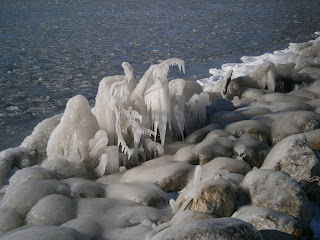Some major newspapers have recently published articles about the usefulness of multi-vitamins and other dietary supplements. Below is a recent story published by the Globe and Mail, one of Canada's premier daily newspapers. Below this story you will find a rebuttal by noted heart-health specialist Eddie Vos of Glen Sutton who has been lecturing on this subject for decades.
I put this on my blog as it is of interest to all and certainly worth considering if you are conscious about your health.
MARGARET WENTE
Why I’m leaving the vitamin church
The Globe and Mail
Published Saturday, Nov. 09 2013, 8:00 AM EST
Last updated Friday, Nov. 08 2013, 5:25 PM EST
I was ahead of the curve on vitamin D. I’ve been popping the “sunshine drug” for years – 1,000 milligrams a day, religiously, all winter long. I felt smug when The New York Times finally caught up to me.
“Vitamin D promises to be the most talked-about and written-about supplement of the decade,” Jane Brody, the paper’s best-known health writer, declared in 2010. “A huge part of the population – from robust newborns to the frail elderly, and many others in between – are deficient in this essential nutrient.”
The horrors of vitamin D deficiency are legion: elevated risk of certain cancers, high blood pressure, heart and kidney disease, MS, uterine fibroids, and – worst of all – fragile bones. (Oh, oh. Better take it year-round.) All of my knowledgeable friends agreed that vitamin D should be an essential part of every woman’s nutrition regimen.
Well, now we can toss those pills down the garbage chute. New findings published in The Lancet say vitamin D supplements don’t seem to improve your bone density after all – or anything else. “Most healthy adults do not need vitamin D supplements,” said Ian Reid, the study’s leader. “Our data suggest that the targeting of low-dose vitamin D supplements only to individuals who are likely to be deficient could free up substantial resources that could be better used elsewhere in health care.”
I feel like a chump. But what else is new? This is just the latest in a long list of debunks of substances as diverse as antioxidants, salt, gluten, fish oil and vitamins A through E. All these things have been the subject of countless scientific studies whose results have been published in important journals. All have been endorsed (or condemned) by the most authoritative bodies – government health agencies, Harvard professors, nutritionists, dietitians and cancer societies, to say nothing of Dr. Oz and Oprah.
And it’s snake oil. All of it.
Most nutrition research is pseudoscience – a giant fraud committed on the public. That is the conclusion reached by Edward Archer, a research fellow at the Arnold School of Public Health at the University of South Carolina. He’s the lead author of a new paper that examines four decades of nutritional surveillance data collected (at a cost of billions) by the U.S. government. This is the basic information used to chart obesity trends and develop dietary recommendations. But the data are worthless, because they depend on people self-reporting what they eat. And people, especially women, are wildly unreliable. If their food intake matched their self-reports, many of them would be dying of starvation.
As Mr. Archer writes in an opinion piece published in The Scientist, “there is a large body of evidence demonstrating that the systematic misreporting of energy and macronutrient intake renders the results and conclusions of the vast majority of federally funded nutrition studies invalid.” He blames a fatal combination of incompetence and self-interest. Nutrition “science,” he charges, is rife with bias. Its research techniques are deeply flawed and the researchers know it, but no one will rock the boat because everyone’s livelihood depends on their next government grant.
Harsh? Not at all. The nutrition racket feeds many interests. One is Big Pharma, which makes a lot of money on the “worried well.” According to Dr. Paul Offit, a well-known and formidable opponent of nutritionism, vitamin supplements are a $30-billion industry. Another beneficiary is Big Food, which uses the miracle (or toxic) ingredients du jour as handy marketing tools. Yesterday, your breakfast cereal had anti-oxidants. Today, it’s gluten-free, and tomorrow it will be sprinkled with magic pixie dust that will help you live forever.
Then there’s the obesity/public health establishment, which, having cured us of our smoking habit, needs other things to do. Obesity is a worthy cause, but it’s also vastly oversimplified. Except at the extremes, nobody really has a handle on the link between weight and various morbidities.
Next up is the vast scientific/academic/research/funding/publishing establishment, where you see all the problems of nutrition science writ large. “There is an intellectual conflict of interest that pressures researchers to find whatever it is that is most likely to get them funded,” Dr. John Ioannidis, the renowned medical meta-researcher, told The Atlantic magazine. Dr. Ioannidis has shaken the science world to its foundations with his conclusion that most medical research is misleading or just plain false. In a nutshell, his argument, as summarized by Atlantic writer David Freedman, is that, “assuming modest levels of researcher bias, typically imperfect research techniques and the well-known tendency to focus on exciting rather than highly plausible theories, researchers will come up with wrong findings most of the time.”
For the record, Dr. Ioannides’s advice with regard to obesity studies is “ignore them all.”
But let’s be honest: The people with the biggest stake in the nutrition racket are you and me. We’ve taken vitamins since birth. We are desperate to believe. We are the self-improvers, the conscientious types who have made a solemn vow to live healthy till we die. We’re proactive. We fill our plates with quinoa and kale. We worry about fibre.
We’re not to be confused with those wacky alt-medicine types with their voodoo potions. We base our diets on sound scientific research, all of which has been endorsed by The New York Times. We are members in good standing of what Dr. Offit calls “the church of vitamins and supplements.” And every morning, we faithfully take communion with our little pills and hope for the best.
Rebuttal of the above:
By Eddie Vos
Leaving the “vitamin church” … not so quickly, not me.
The November 9 opinion piece by
Margaret Wente as to why vitamins from A through E are all “snake oil” is
without scientific support. The article
starts badly when she reports once taking 1000 milligrams [sic] of vitamin D
per day, a toxic dose, rather than the much smaller 1000 IU, one IU being 1/40th
of a millionth of a gram, a dose invisible to the naked eye. A second but somewhat humorous misconception
is that of snake oil itself, one of the oldest known medicines. Traditional snake oil from San Francisco’s China town contained an
amazing amount of the anti-inflammatory omega-3, EPA (Google: “Medline 2773477”).
Fortunately for snakes, their oil can no
longer be found in Montreal’s China town, I checked. Because snake oil was a rare and precious commodity,
unscrupulous salesmen would dilute (any) oil with whatever other oil, giving
salesmen a bad name and, by association, snake oil.
One third of the article is about a Coca Cola financed study about “especially
women” being “wildly unreliable” about calories; nothing to do with vitamins.
The most misleading part of the article is that vitamins A through E do
have important functions and, no matter how well we eat, we are likely low in
many such “minor-nutrients”. While the
sceptics argue, there is overwhelming evidence that it is smart to take a daily
multivitamin, some omega-3 (a fish oil pill if facing heart disease), to use of
canola oil (that has10% omega-3) and a vitamin D and magnesium supplement if
you may be under recommended intakes. This
is, by weight, one tenth of an ounce of prevention, supported by tens of
thousands of credible studies.
There is massive growing evidence that being low in vitamin D, the
sunshine vitamin that cannot be made for about 6 months when your shadow is
longer than your height, is a risk factor for bone fractures and very likely
cancer. One recent Saudi study found an 8 fold increase in breast cancer
between the lowest vitamin D status (in veiled women) and the highest. Then there is the global perspective finding
that supplementing with vitamin D is likely to prevent large numbers of cancers,
especially at our latitudes (Medline 19523595). Like all vitamins, few will cure the disease but, in health, it’s
all about prevention. Similarly, a dry
garage will not cure a rust hole caused by water.
Canada’s top killer,
heart disease. We all make a toxin
called “homocysteine” and it is certain that a multivitamin lowers the amount
in our blood. Vitamins B2, B6, B12 and B9
(folic acid) are the principal actors. There
is no other therapy. Apart from heart disease
(above minimal) homocysteine is also linked to the causes of bone fractures,
Alzheimer’s disease, stroke and macular degeneration, to name a few conditions for
which there is no obvious cure, or drug.
A Canadian study, HOPE-2, found a 25% reduction in strokes from B
vitamins, an example of prevention at a late stage in the game. Just as amazing, giving folic acid and
vitamin B12 to stroke victims caused an 80% reduction in hip fractures in just
2 years (Medline 15741530). No drug matches
that track record. Some of the science
and rationale is given on my not-for-profit web page health-heart.org/why.htm. As
said, vitamins prevent disease but may not cure them in clinical studies. High
blood homocysteine, from common genetic traits and common low B-vitamin intakes,
is causally linked to a myriad of birth defects that, of course, the preventing
vitamins do not fix.
Doctors have to “cure” while prevention is complicated and not evidently
part of their main occupation. Many
diseases have no cure or drug that helps them, a clue that a lack several “minor”
nutrients may be their cause. The high-dose (no-iron) multivitamin I buy has no
child-proof cap on a bottle with a 6 month supply, attesting to the safety of
prevention.


















































